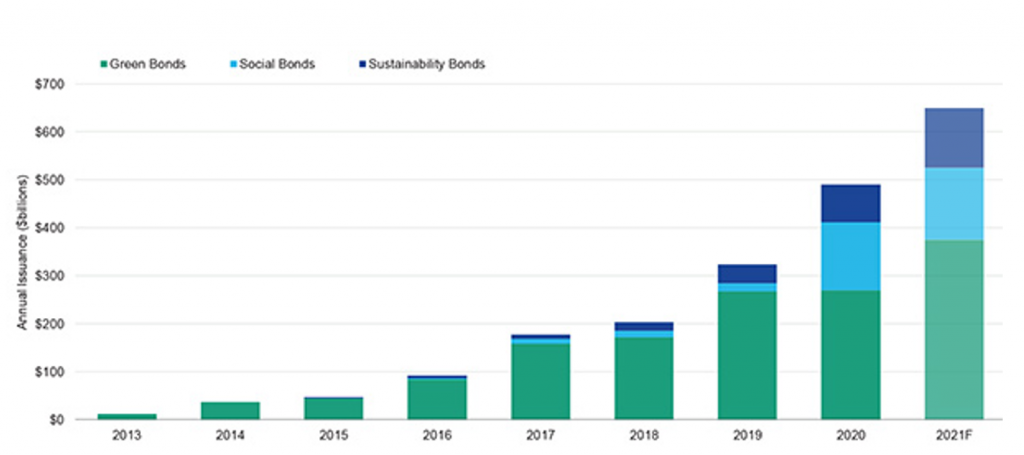The Long and Short
Sustainability-linked bonds, a new corporate trend?
Meredith Contente | June 25, 2021
This document is intended for institutional investors and is not subject to all of the independence and disclosure standards applicable to debt research reports prepared for retail investors. This material does not constitute research.
The new issue corporate bond market produced three sustainability-linked bonds in recent sessions that pay investors with a coupon step-up if the issuer misses certain environmental, social or governance targets. This could become a new trend, and investors may welcome it. SLB bonds hold management teams accountable for hitting a range of goals from emissions standards to improving employee diversity while getting investors more comfortable with credits that face environmental or social issues. With fixed income investors largely financing capital projects, the accountability seems long overdue. Additionally, SLB issuance could benefit sectors that have difficulty issuing Green bonds, such as energy and mining.
SLB or Green Bond– What’s the Difference?
The market has seen a plethora ESG bonds issued over the past year, as demand for these types of issues have increased dramatically given the rise in global awareness of ESG factors. In 2020, we note that approximately $491bn of ESG bonds were issued with Green bonds accounting for over half of ESG issuance. SLB bonds are still relatively new to the market and only accounted for roughly 15% of ESG issuance. In a Green Bond, the proceeds are used to finance a defined ESG project, such as renewable energy or climate change adaptations. However, in an SLB bond, proceeds can be used for general corporate purposes, but the coupon will step at a certain time if key performance indicator thresholds are not achieved. Moody’s forecasts that ESG issuance will hit a new record of $650bn this year with SLB bonds accounting for nearly 20% of the issuance. This translates to SLB issuance growth of 58% from 2020. While global debt volumes are expected to pull back from the record year that the pandemic produced, SLB bonds are likely to continue to increase their share of total global issuance, which we believe will be driven by investor demand and familiarity with the structure.
Exhibit 1. ESG Issuance 2013-2021E

Source: Moody’s Investor Service Inc.
Telus- First Canadian Issuer to Price SLB Bond
Telus (TCN) kicked off the week as the first Canadian issuer to price an SLB bond as part of the company’s SLB framework which was announced earlier this month. TCN has committed to reducing its absolute Scope 1 and Scope 2 greenhouse gas emissions by 46% from 2019 levels. Should TCN fall short of its target by 12/31/30, the bonds will step up 100bps per year. We note that TCN issued C$750mm of the notes and they mature on 11/31/31, so any failure to hit its emission target will only result in one step up. According to TCN, the SLB Framework was approved by the Science Based Targets initiative and is consistent with reductions required to limit global warming to 1.5 degrees Celsius. TCN plans to report annually on its performance in achieving its Sustainability targets, and also plans to obtain independent verification in the form of a limited assurance report on an annual basis. The deal was 3.5x oversubscribed and priced at the tight end of IPT (+137bps).
Enbridge Sees Strong Demand for Inaugural SLB Issuance
Enbridge (ENBCN) priced an inaugural 12yr SLB bond this week, the first in the pipeline sector, that captured investor attention as the order book for the deal was 4x oversubscribed. The new issue differs from TCN’s deal as it has two performance metrics, one related to carbon emissions and the other related to diversity amongst ENBCN’s workforce. Under the first performance metric, the coupon will step up +50bps if ENBCN does not reduce Scope 1 and Scope 2 Emissions intensity by 35% by 12/31/30. Under the second performance metric, the coupon will step up +5bps on 12/31/25 if ethnic or racial minorities account for less than 28% of ENBCN’s workforce. We believe the difference in the coupon steps and targeted deadlines between the performance metrics relates largely to the level of difficulty related to each. ENBCN was able to price the SLB bond 15bps-20bps through IPT (at +105bps) given the demand. We expect the deal to perform well post pricing with demand likely to increase as more investors get familiar with the structure. Post launch, bonds were +3bps tighter.
Mississippi Power Issues 30yr Sustainable Green Bond
Mississippi Power (SO) was also in the market with a sustainable bond, however, we note that the issuance actually looks like a Green bond. The $325mm in proceeds issued are expected to be used to finance/refinance one or more eligible ESG projects. Pending allocation for an ESG project, the company will use the proceeds to redeem $270mm of a Taxable Revenue Bond that matures 10/21/21 and is issued out of Mississippi Business Finance Corp. Since there is no coupon step language associated with key performance metrics, we believe this issuance should be classified as Green bond.


